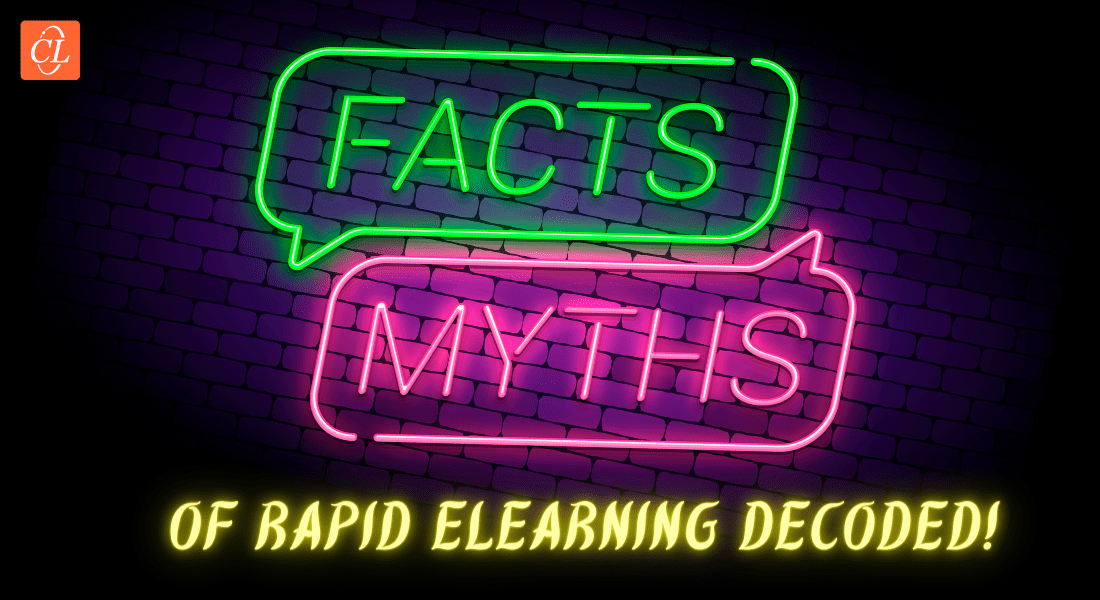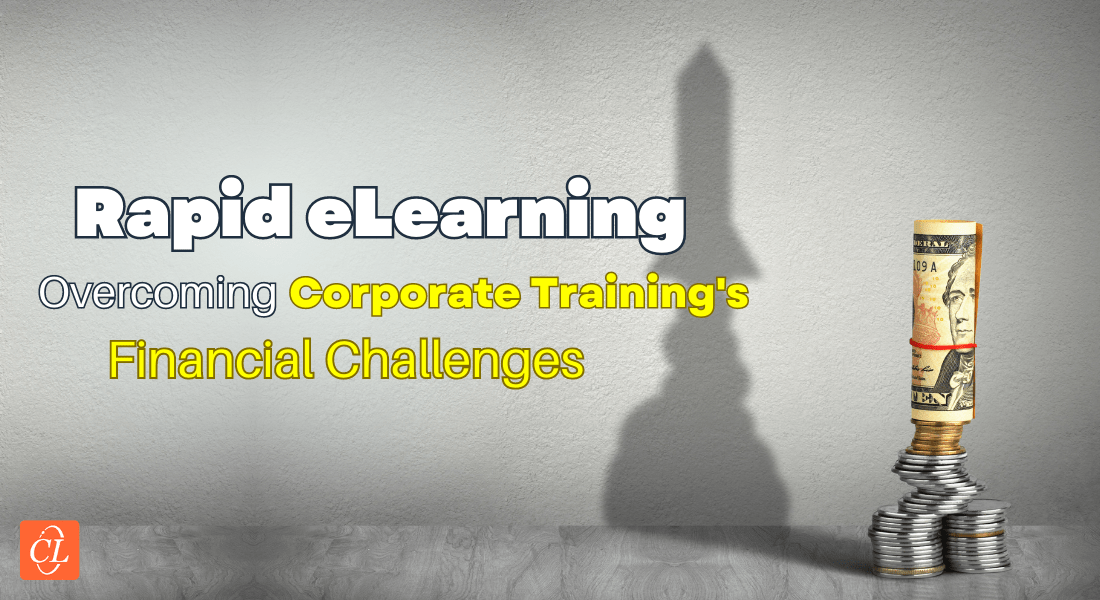Debunking 5 Common Myths About Rapid eLearning: Separating Facts from Fiction
Rapid eLearning is an effective solution for training and development and can revolutionize the way organizations deliver training to their employees. This article addresses and debunks the 5 most common myths associated with rapid eLearning.

Are you looking for a fast and efficient way to develop effective eLearning courses? If so, you may have heard about the concept of rapid eLearning. It is a popular approach to eLearning development that focuses on creating eLearning courses quickly and efficiently. However, with any new concept comes myths and misconceptions, and rapid eLearning is no exception. Despite its popularity, there are several ones surrounding rapid eLearning that can lead to confusion and misinformation. This blog will help you explore some of these myths and misconceptions and dispel them. So, are you ready to separate fact from fiction when it comes to rapid eLearning?
Are You New to Incorporating Rapid eLearning for Your Corporate Training?
Then you Must be Coming Across These 5 Common Myths Frequently –
- It is low quality
- It is only for basic training
- It is a shortcut to development
- It is impersonal
- It is only for small organizations
Read on to debunk these myths and separate facts from fiction.
5 Common Myths About Rapid eLearning: Debunked!
Myth #1: Rapid eLearning is low quality
One of the most common myths surrounding rapid eLearning is that it is low quality. This misconception often arises from the assumption that speed equals poor quality. However, rapid eLearning can produce high-quality courses if developed correctly.
The key to creating high-quality rapid eLearning courses is to focus on instructional design principles, use a rapid eLearning authoring tool that supports multimedia elements, and invest in high-quality graphics and animations. For example, organizations can use rapid authoring tools such as Articulate Storyline or Adobe Captivate to create interactive and engaging eLearning courses. Additionally, involving subject matter experts and conducting thorough testing and evaluation can also help ensure the quality of the course.
→ Download eBook Now – How to Select the Right Rapid Authoring Tool
Myth #2: Rapid eLearning is only for basic training
Another myth about rapid eLearning is that it is only suitable for basic training or simple topics. However, rapid eLearning can be used for a wide range of training programs, from compliance training to technical skills training. The key to successfully using rapid eLearning for more complex training is to have a solid instructional design foundation and to carefully consider the learning objectives and audience needs. By taking the time to plan and design the course effectively, rapid eLearning can be an effective tool for even the most complex training programs.
For example, an organization can use rapid eLearning to train employees on complex software applications by developing interactive simulations that allow learners to practice and apply their skills in a safe and controlled environment. They can also use rapid eLearning to provide leadership development training by creating scenario-based courses that allow learners to practice decision-making and problem-solving skills in a realistic context.
Myth #3: Rapid eLearning is a shortcut to development
Another misconception about rapid eLearning is that it is a shortcut to development. This idea stems from the assumption that rapid eLearning allows for quick development without the need for planning or design. However, effective rapid eLearning development requires careful planning, design, and testing. Rapid eLearning authoring tools and methodologies are designed to speed up the development process, but they still require careful attention to instructional design principles and training needs.
To counter this myth, you can take a thoughtful and strategic approach to rapid eLearning development by following an instructional design process, conducting a needs analysis, and developing a detailed project plan. For example, conventional eLearning development uses the ADDIE (Analysis, Design, Development, Implementation, Evaluation) instructional design model whereas rapid eLearning prefers SAM (Successive Approximation Model) to ensure that the eLearning course is developed quickly with a focus on learner needs and training objectives. You can also develop a detailed project plan that outlines the timeline, budget, and deliverables for the course and streamline the entire process.
Myth #4: Rapid eLearning is impersonal
Another myth about rapid eLearning is that it is impersonal. This myth suggests that rapid eLearning is a cold and impersonal way of delivering training and that it lacks the personal touch of more traditional training methods, such as classroom instruction or one-on-one mentoring. However, this is not necessarily the case. Rapid eLearning can be just as personalized as other training methods, if not more so, depending on the design and implementation. To counter this myth, it’s important to recognize that rapid eLearning can be personalized in a number of ways.
One way to personalize rapid eLearning is through the use of multimedia elements such as audio and video and by incorporating interactive elements such as quizzes, simulations, and scenario-based learning. These elements allow learners to practice and apply their skills in a safe and controlled environment, which can help them to retain information and apply it in real-world situations. Additionally, rapid eLearning can be personalized by allowing learners to self-pace through the course. By providing learners with the ability to choose the pace at which they learn, they can take more time on concepts that are more difficult for them, and move through concepts that are easier more quickly.
Finally, rapid eLearning can be personalized by incorporating social learning elements, such as discussion forums or live webinars. These elements allow learners to connect with their peers and instructors, ask questions, and share experiences, which can help to create a more collaborative and personalized learning experience.
Myth #5: Rapid eLearning is only for small organizations
Finally, a common myth about rapid eLearning is that it is only suitable for small organizations or those with limited resources. This misconception arises from the idea that rapid eLearning is a low-cost solution to training development.
However, rapid eLearning can be used effectively by organizations of all sizes and budgets. Rapid eLearning authoring tools are designed to be flexible and scalable, allowing for the development of large-scale training programs. Additionally, rapid eLearning can be a cost-effective solution when compared to traditional training methods, such as classroom training or virtual instructor-led training.
For example, a large multinational corporation can use rapid eLearning to provide compliance training to thousands of employees across different regions and time zones. They can also use rapid eLearning to provide ongoing professional development training to their employees on a regular basis, regardless of their location. Rapid eLearning allows organizations to create high-quality training programs that meet the needs of their learners, regardless of their size or budget.
Parting Thoughts!
In conclusion, there are several myths and misconceptions surrounding rapid eLearning. However, by understanding these myths and misconceptions and taking a thoughtful and strategic approach to rapid eLearning development, organizations can develop high-quality, effective training programs that meet the needs of their learners. If you are still not convinced about the facts stated above, you can check out this eBook to understand more about rapid eLearning followed by a few best practices instructional designers need to follow to achieve the best results.





